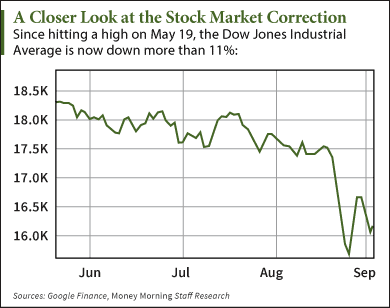Since reaching an intraday high of 18,351.36 on May 19, the Dow Jones Industrial Average has dropped 11.6% through today.
That puts us squarely in correction territory and has led to many readers asking us how to invest during a stock market correction.
For the answer, we turned to Money Morning Executive Editor Bill Patalon. He has more than 30 years' experience as an analyst of business, economics, and the financial markets. He's also  the award-winning author of "Contrarian Investing: Buy and Sell When Others Won't and Make Money Doing It."
the award-winning author of "Contrarian Investing: Buy and Sell When Others Won't and Make Money Doing It."
A stock market correction is defined as a 10% drop from an index's high. While it's not considered a bear market - that's after a 20% drop - a correction usually causes many investors to hit the panic button.
But taking your money out of the market is the wrong move.
You see, great stocks are trading at a discount now. And you don't want to miss profits when the markets inevitably rebound from this stock market correction.
In fact, we recommend having a list - ready at all times - of quality, must-have shares to pick up at "fire sale" prices during sell-offs. So we asked Patalon which stock tops his must-have list now that shares are on sale.
"I like the stocks of companies that are tied into long-term trends and whose share prices are poised to benefit from multiple catalysts," Patalon said.
And the company Patalon recommends now is benefiting from several solid catalysts.
Here's the blue-chip stock Patalon has for those asking how to invest during a stock market correction...
How to Invest During a Stock Market Correction: GE Shares Hit 16% Discount
Patalon recommends picking up shares in General Electric Co. (NYSE: GE) during this stock market correction.
Opening at $24.14 today (Wednesday), GE stock is down 16% from the high it hit in early April.
"Some of the most important forces forming up under GE shares are 'growth triggers,' and the sheer volume of 'insider buying' that's been happening," Patalon said.
"GE is in several growth segments: Aircraft engines, medical-imaging equipment, power generation, water treatment and, as a great special 'kicker' - the 'Internet of Everything' (IoE)," he continued. "Demand in each of those sectors is only going to grow, so GE can take comfort in knowing there will be plenty of demand for its wares long term."
Another bullish sign for GE stock is insider buying. According to Patalon, that is the "single-biggest indicator that a stock is going to move higher."
"Corporate insiders, you see, sell their company's shares for many reasons: tax preparation, estate planning, and diversification are a few examples," he explained. "But insiders buy for only one reason - they see a chance to make money on their own stock."
In 2014, CEO Jeffrey Immelt bought an additional 40,000 shares of GE. That brought his total investment to more than $47 million worth of GE stock.
[mmpazkzone name="in-story" network="9794" site="307044" id="137008" type="4"]
"And Immelt wasn't alone," Patalon said. "Two independent GE directors - Geoffrey Beattie and James Rohr - bought an aggregate 14,000 shares between them, spending $103,000 to do so."
Those three purchases were all made near $25 per share. That means you can get in now at an even lower price than those insiders.
"In a market like this, you don't have to go 'all in' on a stock all at once," Patalon said. "Look to 'accumulate' shares - adding to your position each time the stock trades back. That's a winning long-term investment strategy - in a short-term rocky stock market."
Follow us on Twitter @KyleAndersonMM and @moneymorning.
Like us on Facebook: Money Morning.
Protect Yourself from a Total Market Collapse: According to CIA Asymmetric Threat Advisor Jim Rickards, there are five "flashpoints" that signal the death of the U.S. dollar and a complete economic collapse in the United States. Here's how you can protect yourself, and your money, before it's too late...


